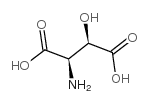Serine racemase homologue of Saccharomyces cerevisiae has L-threo-3-hydroxyaspartate dehydratase activity.
Masaru Wada, Shigeru Nakamori, Hiroshi Takagi
Index: FEMS Microbiol. Lett. 225(2) , 189-93, (2003)
Full Text: HTML
Abstract
The NH(2)-terminal amino acid sequence of L-threo-3-hydroxyaspartate dehydratase from Pseudomonas sp. T62 showed significant similarity to that of the SRY1 gene product of Saccharomyces cerevisiae (serine racemase in yeast). SRY1 was cloned and expressed in Escherichia coli, and the gene product was purified and partially characterized. The SRY1 gene product exhibited dehydratase activity specific for L-threo-3-hydroxyaspartate (K(m)=3.9 mM, V(max)=110 micromol min(-1) (mg protein)(-1)) but not for D-threo- or DL-erythro-3-hydroxyaspartate. The purified enzyme showed no detectable serine racemase activity. The activity of the enzyme was inhibited by hydroxylamine and EDTA, and was activated by Mg(2+), Ca(2+), and Mn(2+), suggesting that pyridoxal-5'-phosphate and divalent cations participate in the enzyme reaction. Gene disruption and overexpression indicated that SRY1 is responsible for the 3-hydroxyaspartate resistance of S. cerevisiae. To our knowledge, this is the first report of 3-hydroxyaspartate dehydratase activity in eukaryotic cells.
Related Compounds
| Structure | Name/CAS No. | Molecular Formula | Articles |
|---|---|---|---|
 |
DL-Threo-beta-Hydroxyaspartic Acid
CAS:4294-45-5 |
C4H7NO5 |
|
The SLC1 high-affinity glutamate and neutral amino acid tran...
2013-01-01 [Mol. Aspects Med. 34(2-3) , 108-20, (2013)] |
|
A concise, asymmetric synthesis of (2R,3R)-3-hydroxyaspartic...
2008-08-01 [Amino Acids 35(2) , 507-10, (2008)] |
|
Insights into the mechanism of Pseudomonas dacunhae aspartat...
2010-06-22 [Biochemistry 49 , 5066-73, (2010)] |
|
Neuroprotective effects of yokukansan, a traditional Japanes...
2009-04-10 [Neuroscience 159(4) , 1397-407, (2009)] |
|
Non-heme hydroxylase engineering for simple enzymatic synthe...
2008-02-15 [ChemBioChem. 9(3) , 374-6, (2008)] |